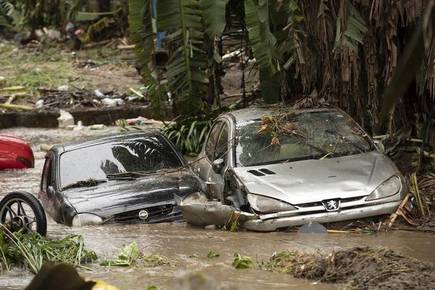Anthony Iwuoma
It was the late legendary afrobeat maestro, Fela Anikulapo Kuti, who sang a hit song that said ‘water no get enemy’.
However, with the recent experiences in Nigeria, it has become doubtful if truly ‘water no get enemy’. This is because angry waters have swallowed many parts of Nigeria as if on a vengeful mission. Some areas could be said to be practically floating on top of the water, reminiscent of the biblical days of Noah when God destroyed the first world with water.
READ ALSO: Lagos, Bayelsa, Kogi, others battle flood menace
The only difference now is the hope of God’s assurance that never again would he destroy the earth with water, otherwise one could feel this may be the end.
Well, that has not stopped the magnitude of devastation Nigeria has witnessed recently due to flooding that began towards the end of September.
In addition to the unquantifiable number of prized properties and the destruction of farmlands and crops, this year’s tragic experience across all parts of the country is said to be the worst since 2012.
According to the Minister of Humanitarian Affairs, Disaster Management and Social Development, Sadiya Umar Farouq, who addressed a press conference, by 16 October, 2,504,095 persons had been affected, with 603 dead, 2407 injured and 1,302,589 displaced, including the more than 200,000 homes, which were destroyed.
Actually, the Nigeria Meteorological Agency, NIMET, in August, predicted that 32 states would experience flooding this year. As Nigerians are wont, the warning was not taken seriously, even when the government urged residents of flood-prone areas to relocate.
So far, Plateau was one of the states badly hit by the disaster, as about 13 communities in Langtang South Local Council were submerged, leading to the displacement of many residents.
In the same local council alone, about 220 houses and a lot of farmlands were flooded. Bridges linking some communities were also washed away by floodwater.
In Langtang North, about 400 houses were submerged by flood in the Pilgani District of the council where Zamadede, Shilur, Pishe, Angwani, Galang, and other communities were affected.
The story is not so different from the ugly experiences in Nyelleng and Gwabi communities in Pankshin Local Council of the state where, at least, four people, including a couple were killed by the flood.
In Kogi State, about nine local councils, including Lokoja, Kogi-Koto, Ajaokuta, Ofu, Igalamela-Odolu, Bassa, Idah, Ibaji and Omala were affected, resulting in the submerging of farmlands, houses, and roads. It was so devastating the state governor, Yahaya Bello, had to call on President Muhammadu Buhari to declare an emergency and assist the victims whose livelihoods have been badly affected.
Likewise, Lokoja and adjoining local councils were submerged by flood, as well as several communities and farmlands due to the overflow of Rivers Niger and Benue.
Some major roads in Lokoja, such as the Old Market road and Ganaja-Ajaokuta and Lokoja-Abuja road were flooded. The roads are very important because they connect the North with the south-eastern and south-western parts of the country. Hence, for many days, several passengers were stranded on the road while some resorted to using a canoe to cross over to the unaffected side before boarding other vehicles to continue their journey. Also, people were seen relocating to safer places with a few of their belongings.
Many residents, some of whom found refuge at the Internally Displaced Persons (IDP) camp at St. Luke’s Primary School, Adankolo in Lokoja, lamented that they watched helplessly as the flood washed away all their prized possessions.
In Ohaji/Egbema and Oguta local councils of Imo State, the ancestral houses, property, farmlands, and other belongings of residents of Eziorsu, Egbuoma, Egbema, and Oguta Lake areas were similarly submerged.
Also, in Owerri metropolis, the flood did not spare Works Lay Out, Ikenegbu Lay Out and Chukwuma Nwoha by MCC Road, as residents suffered like destructions by flood after recent heavy rainfall.
Reports from Anambra State revealed that the flood was unsparing in many communities in the state where no fewer than 11 people were feared killed. Many villages were submerged and houses, schools, places of worship, and healthcare centres, police stations, and other public places were affected.
The affected communities included Ogbaru, Anyanelum, Awka North, Anambra East, and West.
The state government quickly set up IDP camps at Central Primary School, Ifite-Ogwari, and Otaku Primary School, Omor both in Anyanelum Local Council; Crowther Memorial Primary School, Onitsha, and Unity Hall, Umueri, among others, to assist the victims.
A major casualty of the flooding in the state was the bridge, linking seven communities and several camps in Ogbaru Local Council, which collapsed on October 12, thereby cutting off several communities and thousands of people already trapoed by the flooding.
There were reports of deaths too, which the Southeast Coordinator of, the National Emergency Management Agency (NEMA), Mr. Thichman Tanimu, confirmed. He identified one of the dead as Ginikanwa Izuoba in the Enugu-Otu, Aguleri, following the collapse of his house due to the rampaging flood.
According to Tanimu, at least 651,053 persons in six local councils were displaced, out of which Ogbaru accounted for 286,000 victims, Anambra West 237,000, Anambra East 103,000, and Anyanelum 9, 240.
In the last month, Abia State recorded 13 deaths in Aba South and Osisioma Ngwa local councils, including 10 children and three adults. Farmlands and houses were also submerged, with goods and properties worth millions of naira destroyed.
A bridge at Akanu Item in Bende Local Council collapsed as a result of the flood, cutting off the community from others. At Nkporo in Ohafia Local Council, three communities and houses were submerged, following the overflow of the Ironyi River.
The flooding caused huge losses at Ariaria International Market, Aba. Though no lives were lost, it destroyed properties and goods worth several millions of naira.
Residents of Rivers State were displaced and rendered homeless in their thousands, as about 40 communities in three local councils of the state were submerged by angry floods. They included Ogba/Egbema/Ndoni, Ahoada West, and Ahoada East. Some of the affected communities are Usomini, Omoku, Obrikom, parts of Egi, Egbema, and Ndoni where Governor Nyesom Wike approved N1 billion for the provision of emergency relief materials to the victims. Some of the now homeless and jobless victims appealed to the governor to ensure that the money is not mismanaged, as was the case in the past when relief items meant for victims were diverted.
Bayelsa State could be counted among the worst-hit states.
With10 reported deaths and loss of homes and properties, many communities have been deserted in Bayelsa State, following the rampaging flood. Yenagoa, the state capital, was also affected.
One 16-year-old boy, identified as Temedi Agbede Yerimene, who was reportedly swimming in the rising water close to the State Ecumenical Centre, was overpowered by the tide and swept away by the flood at Igbogene community in Yenagoa Local Council. His corpse was later recovered two days after from a deep canal close to the entrance of the state capital.
The flood also submerged Ayakoro settlement in Ogbia Local Council, killing three people. A middle-aged woman also reportedly died in Mbiama, when the flood submerged her home.
According to the Executive Secretary, Kebbi State Emergency Management Agency, Alhaji Abbas Rabiu Kamba, no fewer than 200 villages were affected by the recent flood in the state. He added that over 1000 families were affected in 12 local councils.
In fact, apart from the deaths, the immediate consequence of the devastation is its huge negative impact on already bad food security in the country. Food items have become more scarce and where available the cost has risen astronomically beyond the reach of many suffering Nigerians.
The devastation is complete. Many graves have been submerged and coffins dug up, and their ghostly contents exposed. Well over 100,000 hectares of farmland and crops have been destroyed, resulting in the high cost of essential commodities. Fishermen have also lost their means of livelihood, as they could no longer fish.
Roads have collapsed, cutting off communities and making travel a hellish experience, and those living on the islands are trapped.
Several government bodies, NGOs, foreign charities, indigenous philanthropists, and even politicians have risen to rally assistance to the victims by making huge financial and material donations.
Unfortunately, the Nigerian authorities have not managed the disaster well due to their lethargic approach to the problem. Rather than being proactive, the National Emergency Management Agency, NEMA, and other associated agencies prefer to wait and then run from pillar to post after each flooding disaster when it distributes mattresses, foodstuffs, and miserly sums of money to the hapless flood victims.
Even regular weather data released by the NIMET are hardly utilised by the agencies of government in charge of disaster management.
The Federal Government has also accused the states of ignoring warnings.
As always, the devastation has been blamed on ‘Climate Change’ due to environmental degradation.
However, one major cause of perennial flooding in Nigeria is river and ocean surges by tides, which push water to overflow its boundaries downstream, hence submerging some states like Adamawa, Benue, Anambra, and Kogi. Rivers Niger and Benue also overflow their banks into neighbouring communities, resulting in silt deposits and consequent flooding of dry lands.
Indeed, climate change is the main culprit, but not the only cause of flooding.
To worsen matters, rainfall this year has been higher than usual all over the country. Moreover, last month, the authorities in neighbouring Cameroon released excess water from the Lagdo Dam. It is baffling why Nigeria has failed to construct its own dam to counter this recurrent action by Cameroon despite agreeing as far back as the 1980s to do so in Adamawa State.
One can only hope that President Muhammadu Buhari’s recent directive to relevant ministries and state governments to develop a holistic flood prevention action plan is taken seriously. Despite the fact that he just realised the need for what should have been done in the past seven years he has been in office, it is safe to assume that he is not about to dodge his responsibility like the fuel subsidy trap he has set for his successor next year. It should be manageably consoling that the president wants to lay the groundwork for the incoming government, which must follow up and tackle this human disaster conclusively.


